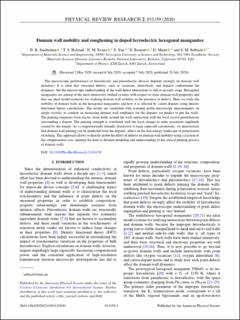| dc.contributor.author | Småbråten, Didrik Rene | |
| dc.contributor.author | Holstad, Theodor Secanell | |
| dc.contributor.author | Evans, Donald | |
| dc.contributor.author | Zewu, Yan | |
| dc.contributor.author | Bourret, Edith | |
| dc.contributor.author | Meier, Dennis | |
| dc.contributor.author | Selbach, Sverre Magnus | |
| dc.date.accessioned | 2020-09-08T07:06:57Z | |
| dc.date.available | 2020-09-08T07:06:57Z | |
| dc.date.created | 2020-08-12T08:37:33Z | |
| dc.date.issued | 2020 | |
| dc.identifier.citation | Physical Review Research. 2020, 2 (3), . | en_US |
| dc.identifier.issn | 2643-1564 | |
| dc.identifier.uri | https://hdl.handle.net/11250/2676775 | |
| dc.description.abstract | The macroscopic performance of ferroelectric and piezoelectric devices depends strongly on domain wall dynamics. It is clear that structural defects, such as vacancies, interstitials, and dopants codetermine the dynamics, but the microscopic understanding of the wall-defect interactions is still at an early stage. Hexagonal manganites are among of the most intensively studied systems with respect to static domain wall properties and thus are ideal model materials for studying domain wall mobility in the presence of defects. Here we study the mobility of domain walls in the hexagonal manganites and how it is affected by cation dopants using density functional theory calculations. The results are correlated with scanning probe microscopy measurements on single crystals, to confirm an increasing domain wall roughness for the dopants we predict to pin the walls. The pinning originates from elastic strain fields around the walls interacting with the local crystal perturbations surrounding a dopant. The pinning strength is correlated with the local change in order parameter amplitude caused by the dopant. As a computationally friendly alternative to large supercell calculations, we demonstrate that domain wall pinning can be predicted from the dopants’ effect on the free-energy landscape of polarization switching. This approach allows to directly probe the effect of defects on domain wall mobility using a fraction of the computational cost, opening the door to detailed modeling and understanding of the critical pinning process of domain walls. | en_US |
| dc.language.iso | eng | en_US |
| dc.publisher | American Physical Society | en_US |
| dc.rights | Navngivelse 4.0 Internasjonal | * |
| dc.rights.uri | http://creativecommons.org/licenses/by/4.0/deed.no | * |
| dc.title | Domain wall mobility and roughening in doped ferroelectric hexagonal manganites | en_US |
| dc.type | Peer reviewed | en_US |
| dc.type | Journal article | en_US |
| dc.description.version | publishedVersion | en_US |
| dc.source.pagenumber | 9 | en_US |
| dc.source.volume | 2 | en_US |
| dc.source.journal | Physical Review Research | en_US |
| dc.source.issue | 3 | en_US |
| dc.identifier.doi | 10.1103/PhysRevResearch.2.033159 | |
| dc.identifier.cristin | 1822885 | |
| dc.relation.project | Notur/NorStore: ntnu243 | en_US |
| dc.relation.project | Notur/NorStore: NN9264K | en_US |
| dc.relation.project | Norges forskningsråd: 231430 | en_US |
| dc.description.localcode | Published by the American Physical Society under the terms of the Creative Commons Attribution 4.0 International license. Further distribution of this work must maintain attribution to the author(s) and the published article's title, journal citation, and DOI. | en_US |
| cristin.ispublished | true | |
| cristin.fulltext | original | |

